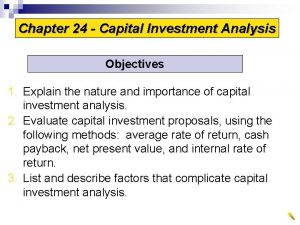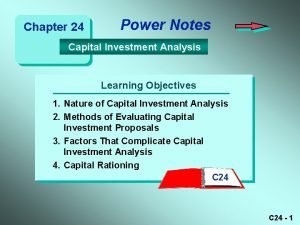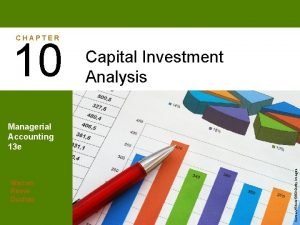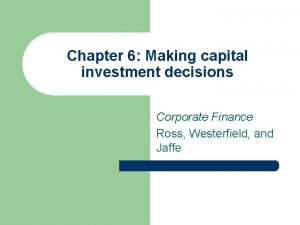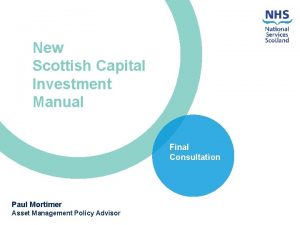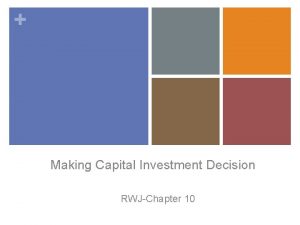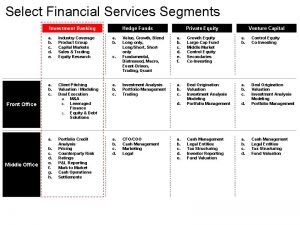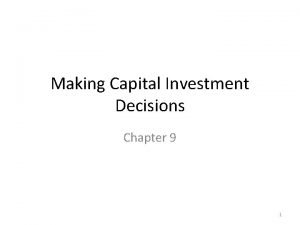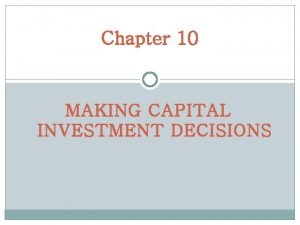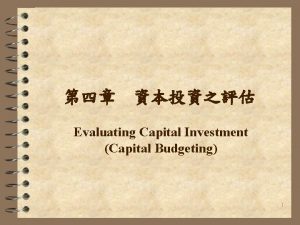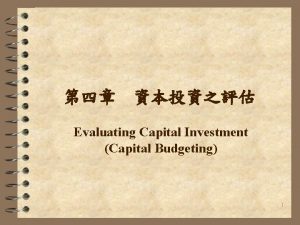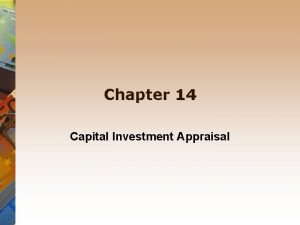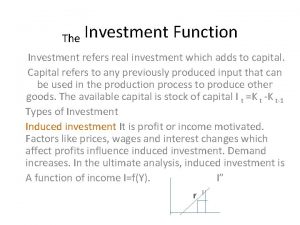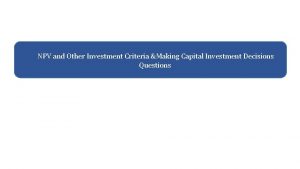11 Capital Investment Analysis The Capital Investment Process



































- Slides: 35

11 Capital Investment Analysis

The Capital Investment Process OBJECTIVE 1: Define capital investment analysis, state the purpose of the minimum rate of return, and identify the methods used to arrive at that rate.

The Capital Investment Process • Capital investment decisions are decisions about when and how to spend on capital facilities and other long-term projects.

Figure 1 Time Span of the Capital Investment Planning Process

The Capital Investment Process • Capital investment analysis – The process of making decisions about capital investments

The Capital Investment Process • Capital investment analysis (cont. ) – Capital budgets and master budgets • The capital investment budget fits into both the long -term planning process and the capital investment process. • Long-term plans are not very specific; they are expressed in broad, goal-oriented terms. • Each annual budget must help accomplish the organization’s long-term goals.

The Capital Investment Process • Capital investment analysis in the management process – Identificationof capital investment needs – Formal requests for capital investments – Preliminary screening

The Capital Investment Process • Capital investment analysis in the management process (cont. ) – Establishment of the acceptance-rejection standard – Evaluation of proposals – Capital investment decisions

The Capital Investment Process • Minimum rate of return on investments is often referred to a as hurdle rate because it is the rate the must be exceeded.

The Capital Investment Process • Cost of capital – Defined as the weighted-average rate of return that a company must pay to its long-term creditors and shareholders for the use of their funds

The Capital Investment Process • Cost of capital (cont. ) – Cost of capital calculation • Identify the cost of each source of capital. • Compute the proportion (percentage) of the organization’s total amount of debt and equity that each source of capital represents. • Multiply each source’s cost by its proportion of the capital. • Total the weighted costs computed in Step 3.

The Capital Investment Process • Other measures of determining minimum rate of return • Ranking capital investment proposals

© 2011 Cengage Learning All Rights Reserved. May not be scanned, copied or duplicated, or posted to a publicly accessible website, in whole or in part.

Measures Used in Capital Investment Analysis OBJECTIVE 2: Identify the types of projected costs and revenues used to evaluate alternatives for capital investment.

Measures Used in Capital Investment Analysis • Discuss the types of information relevant to capital investment decisions: – Net income and net cash inflows or cost savings – Equal versus unequal cash flows – Carrying value of assets

Measures Used in Capital Investment Analysis • Discuss the types of information relevant to capital investment decisions: (cont. ) – Depreciation expense (a noncash expense) and income taxes – Disposal or residual values

© 2011 Cengage Learning All Rights Reserved. May not be scanned, copied or duplicated, or posted to a publicly accessible website, in whole or in part.

The Time Value of Money OBJECTIVE 3: Apply the concept of the time value of money.

The Time Value of Money • The time value of money is the concept that cash flows of equal dollar amounts have different values at different times because of the effect of compound interest.

The Time Value of Money • Find the present values of – A single sum due in the future. – An ordinary annuity.

The Time Value of Money • Discuss the difference between a single payment and a series of payments.

© 2011 Cengage Learning All Rights Reserved. May not be scanned, copied or duplicated, or posted to a publicly accessible website, in whole or in part.

The Net Present Value Method OBJECTIVE 4: Analyze capital investment proposals using the net present value method.

The Net Present Value Method • Discounted cash flow – Table 1 in the appendix deals with a single payment or amount. – Table 2 in the appendix is used for a series of equal periodic amounts.

The Net Present Value Method • Net present value method – Positive net present value means proposed investment will achieve at least the minimum rate of return. – Negative net present value means a proposed investment will not achieve the minimum rate of return and should be rejected.

© 2011 Cengage Learning All Rights Reserved. May not be scanned, copied or duplicated, or posted to a publicly accessible website, in whole or in part.

Other Methods of Capital Investment Analysis OBJECTIVE 5: Analyze capital investment proposals using the payback period method and the accounting rate-of-return method.

Other Methods of Capital Investment Analysis • Payback period method – Formula: Payback period = Cost of investment ÷ Annual net cash inflows – The answer should be expressed in number of years.

Other Methods of Capital Investment Analysis • Payback period method (cont. ) – If a proposed capital investment has unequal annual net cash inflows, the payback period is determined by subtracting each annual amount (in chronological order) from the cost of the capital facility. – Useful in areas where technology changes rapidly

Other Methods of Capital Investment Analysis • Payback period method (cont. ) – Disadvantages • The payback period method does not measure profitability. • It ignores differences in the present values of cash flows from different periods; thus, it does not adjust cash flows for the time value of money. • Because it emphasizes the time it takes to recover the investment rather than the long-term return on the investment, it ignores all future cash flows after the payback period is reached.

Other Methods of Capital Investment Analysis • Accounting rate-of-return method – Formula: Accounting rate of return = Average annual net income ÷ Average investment cost. • Compute the average annual net income. • Compute the average investment cost in a proposed capital facility • Compute the accounting rate of return.

Other Methods of Capital Investment Analysis • Accounting rate-of-return method (cont. ) – The answer should be expressed as a percentage. – Advantages • Easy to understand apply

Other Methods of Capital Investment Analysis • Accounting rate-of-return method (cont. ) – Disadvantages • Because net income is averaged over the life of the investment, it is not a reliable figure; actual net income may vary considerably from the estimates. • The method is unreliable if estimated annual net incomes differ from year to year.

Other Methods of Capital Investment Analysis • Accounting rate-of-return method (cont. ) – Disadvantages (cont. ) • It ignores cash flows. • It does not consider the time value of money; thus, future and present dollars are treated as equal.

© 2011 Cengage Learning All Rights Reserved. May not be scanned, copied or duplicated, or posted to a publicly accessible website, in whole or in part.
 Factors that complicate capital investment analysis
Factors that complicate capital investment analysis Factors that complicate capital investment analysis
Factors that complicate capital investment analysis Factors that complicate capital investment analysis
Factors that complicate capital investment analysis Factors that complicate capital investment analysis
Factors that complicate capital investment analysis Fixed investment and inventory investment
Fixed investment and inventory investment Equivalent annual cost method
Equivalent annual cost method Working capital investment example
Working capital investment example Scottish capital investment manual
Scottish capital investment manual Capital investment decision
Capital investment decision Making capital investment decisions
Making capital investment decisions Banking products and services
Banking products and services Making capital investment decisions
Making capital investment decisions Cca formula
Cca formula Making capital investment decisions
Making capital investment decisions Nwc change
Nwc change Hình ảnh bộ gõ cơ thể búng tay
Hình ảnh bộ gõ cơ thể búng tay Slidetodoc
Slidetodoc Bổ thể
Bổ thể Tỉ lệ cơ thể trẻ em
Tỉ lệ cơ thể trẻ em Voi kéo gỗ như thế nào
Voi kéo gỗ như thế nào Chụp tư thế worms-breton
Chụp tư thế worms-breton Chúa sống lại
Chúa sống lại Các môn thể thao bắt đầu bằng tiếng đua
Các môn thể thao bắt đầu bằng tiếng đua Thế nào là hệ số cao nhất
Thế nào là hệ số cao nhất Các châu lục và đại dương trên thế giới
Các châu lục và đại dương trên thế giới Công thức tính thế năng
Công thức tính thế năng Trời xanh đây là của chúng ta thể thơ
Trời xanh đây là của chúng ta thể thơ Cách giải mật thư tọa độ
Cách giải mật thư tọa độ Làm thế nào để 102-1=99
Làm thế nào để 102-1=99 Phản ứng thế ankan
Phản ứng thế ankan Các châu lục và đại dương trên thế giới
Các châu lục và đại dương trên thế giới Thể thơ truyền thống
Thể thơ truyền thống Quá trình desamine hóa có thể tạo ra
Quá trình desamine hóa có thể tạo ra Một số thể thơ truyền thống
Một số thể thơ truyền thống Bàn tay mà dây bẩn
Bàn tay mà dây bẩn Vẽ hình chiếu vuông góc của vật thể sau
Vẽ hình chiếu vuông góc của vật thể sau
